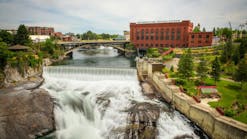Stream Restoration to Improve Water Quality & Wildlife Habitats
Stream restoration is the systematic modification of physical, chemical, and biological conditions to create an ecosystem trajectory toward higher-functioning natural ecological processes and services. Grassy Creek is a tributary to the North Toe River in northwestern North Carolina with water quality and habitat impairments due to stream-bank erosion, storm water runoff and the loss of riparian buffer in a constrained urban environment. A 3,000-ft segment of Grassy Creek in Spruce Pine, N.C., was restored in 2015 and 2016 with the goals of improving water quality and habitats, specifically for the significantly rare eastern hellbender salamander (Cryptobranchus a. alleganiensis) and other aquatic fauna, including trout. Specific habitat requirements for the salamander include areas of fast-moving flow to facilitate absorption of dissolved oxygen through the animal’s skin, deep pools with flat shelter rocks and sand for nesting, and a food supply of crayfish.
The grant-funded design-build restoration project managed by Toe River Valley Watch included the following components:
- Stream channel realignment and floodplain reconnection to provide natural equilibrium bank-full morphology;
- In-stream structures, including log and rock vanes for habitat enhancement and bank erosion reduction;
- Stream-bank wood toe revetments to reduce erosion in meander bends and support pool habitats;
- Planting native riparian buffer vegetation and removing invasive plants; and
- Installation of constructed storm water wetlands to collect and treat runoff from adjacent impervious surfaces.
During construction and planting, educational workshops were conducted to teach contractors, consultants and agency representatives about natural stream restoration techniques. A nature trail was installed parallel to the restored stream reach with signs to educate the public about water quality, aquatic habitats and storm water control.
Project success is being monitored using water quality samples and biological community assessments of fish, macroinvertebrates and salamanders. Results to date indicate the stream ecosystem is stable with a growing, diverse plant and animal community. Biological monitoring has documented that a population of hellbenders is now living in the restored stream segment. This project serves as a demonstration of successful urban stream restoration that will be replicated in this watershed and in surrounding areas to achieve environmental objectives.






